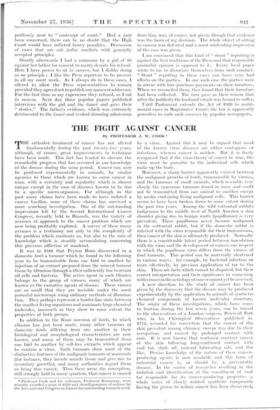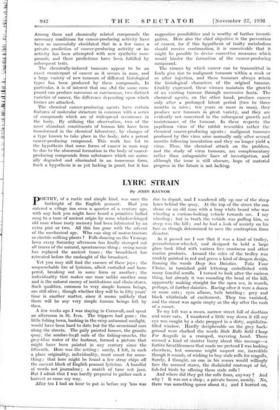THE FIGHT AGAINST CANCER
By PROFESSOR J. W. COOK*
THE orthodox treatment of cancer has not altered fundamentally during the past twenty-five years, although, of course, great improvements in technique have been made. This fact has tended to obscure the remarkable progress that has occurred in our knowledge of the disease during the same period. Cancer can now be produced experimentally in animals, by similar agencies to those which are known to cause cancer in man, with a certainty and regularity which is almost unique except in the case of diseases knoWn to be due to a specific mier6-organism. For although in the past many claims have been made to have isolated a cancer bacillus, none of these claims has survived a more searching investigation. One of the outstanding impressions left by the Second International Cancer Congress, recently held in Brussels, was the variety of avenues of approach to the cancer problem which are now being profitably explored. A survey of these many avenues is a testimony not only to the complexity of the problem which confronts us, but also to the sum of knowledge which is steadily accumulating concerning thiS grievous affliction of mankind.
It was in 1910 that Peyton Rous discovered in a domestic fowl a tumour which he found in the following year to be transmissible from one bird to another by injection of an extract prepared from the minced tumour tissue by filtration through a filter sufficiently fine to retain all cells and bacteria. The active agent in such filtrates belongs to the group of viruses, many of which are known as the causative agents of disease. These viruses are so small that they are invisible under the most powerful microscope using ordinary methods of illumina- tion. They perhaps represent a border-line state between the smallest living organisms and inanimate large chemical molecules, inasmuch as they show to some extent the properties of both groups.
In addition to the Rous sarcoma of fowls, to which allusion has just been made, many other tumours of domestic fowls differing from one another in their histological and morphological characteristics are now known; and many of them may be transmitted from one bird to another by cell-free extracts which appear to contain a virus. Such tumours show most of the • distinctive features of the malignant tumours of mammals (for instance, they invade muscle tissue and give rise to secondary growths), and many authorities regard them as being true cancer. Thus there arose the conception, still strongly held in many quarters, that cancer is caused * Professor Cook and his colleague, Professor Kennaway, were recently awarded a prize of £350 and 50 milligrammes of radium by the International Congress on Cancer for outstanding research. work. by a virus. Against this it may be argued that most of the known virus diseases arc either contagious or infectious, whereas cancer is neither. But it is freely recognised that if the virus theory of cancer be true, the virus must be parasitic to the individual cells which make up the body.
Moreover, a sharp barrier apparently existed between the malignant growths of fowls, transmissible by viruses, and the tumours of small animals, which resemble very closely the cancerous tumours found in man, and could not be transmitted from one animal to another except by media containing living malignant cells. This barrier seems to have been broken down to some extent during the past two years. Among the wild cottontail rabbits indigenous to the middle west of North America a skin disorder giving rise to benign warts (papillomas) is very prevalent. These papillomas never become malignant in the cottontail rabbit, but if the domestic rabbit is infected with the virus responsible for their transmission, then cancer of the skin is ultimately produced. Normally there is a considerable latent period between inoculation with the virus and the development of cancer, one respect in which the papilloma virus differs from the viruses of fowl tumours. This period can be materially shortened in various ways ; for example, by bacterial infection or more effectively, by previous application of tar to the skin. These are facts which cannot be disputed, but their correct interpretation and their significance in connexion with viruses in the aetiology of cancer cannot yet be assessed.
A new direction to the study of cancer has been given by the discovery that the disease may be produced experimentally by the application to animals of synthetic chemical compounds of known molecular structure. The origin of these investigations, which have come to fruition during the last seven years, can be traced to the observations of a London surgeon, Percivall Pott who, in his Chirurgical Observations published hi 1775, recorded his conviction that the cancer of the skin .prevalent among chimney sweeps was due to their occupation, and caused by prolonged contact with soot. It is now known that workmen contract cancer of. the skin following long-continued contact with coal tar, shale oil, mineral lubricating oils, and the like. Precise knowledge of the nature of these cancer- producing agents is now available and this form Of industrial cancer is, or should be, a preventable disease. In the course of researches resulting in the isolation and identification of the constituent of coal tar responsible for its cancer-producing properties a whole series of closely related synthetic compounds having the power to induce cancer has been discovered, Among these and chemically related compounds the necessary conditions for cancer-producing activity have been so successfully elucidated that in a few cases a private prediction of cancer-producing activity or in- activity has been attempted with new synthetic com- pounds, and these predictions have been, fulfilled by subsequent tests.
The chemically-induced tumours appear to be an exact counterpart of cancer as it occurs in man, and a large variety of new tumours of different histological types has been produced by these compounds. In particular, it is of interest that one a4id the same com- pound can produce sarcomas or carcinomas, two distinct varieties of cancer, the difference depending upon which tissues are attacked.
The chemical cancer-producing agents have certain features of molecular structure in common with a series of compounds which are of widespread occurrence in the body. By utilising this observation, two of the most abundant constituents of human bile have been transformed in the chemical laboratory, by changes of a type known to take place in the body, into a potent cancer-producing compound. This work has led to the hypothesis that some forms of cancer in man may be due to the abnormal formation in the body of cancer- producing compounds from substances which are norm- ally degraded and eliminated in an innocuous form. Such a hypothesis is as yet lacking in proof, but it has suggestive possibilities and is worthy of further investi- gation. Here also the chief objective is the prevention of cancer, for if this hypothesis of faulty metabolism should receive confirmation, it is conceivable that it might be possible to devise corrective measures which would hinder the formation of the cancer-producing compound. • The viruses by which cancer can be transmitted in fowls give rise to malignant tumours within a week or so after injection, and these tumours always retain the histological characters of the original tumour. Crudely expressed, these viruses maintain the growth of an existing tumour through successive hosts. The chemical agents, on the other hand, produce cancer only after a prolonged latent period (two to three months in mice ; ten years or more in man), they produce new tumours in great variety, and they are evidently not concerned in the subsequent growth and maintenance of the tumour. In these respects the papilloma virus of• the rabbit resembles rather the chemical cancer-producing 'agents ; malignant tumours produced by this virus arise normally only after several months following inoculation and they no longer yield a virus. Thus, the chemical attack on the problem, and the study of virus tumours, are complementary rather than antagonistic lines of investigation, and although the issue is still obscure, hope of material progress in the future is not lacking.















































 Previous page
Previous page